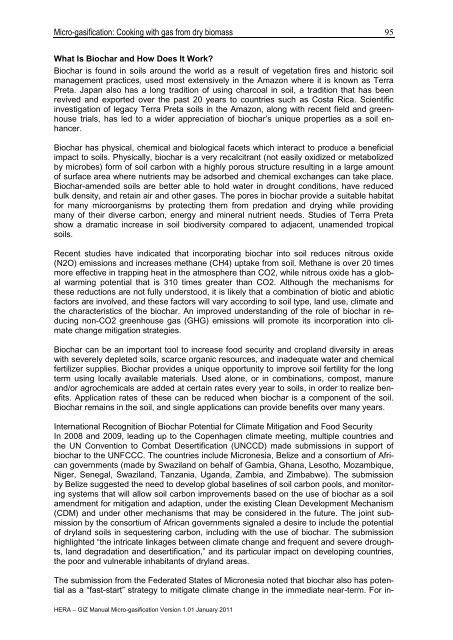Micro-gasification: Cooking with gas from biomass - Amper
Micro-gasification: Cooking with gas from biomass - Amper
Micro-gasification: Cooking with gas from biomass - Amper
Create successful ePaper yourself
Turn your PDF publications into a flip-book with our unique Google optimized e-Paper software.
<strong>Micro</strong>-<strong><strong>gas</strong>ification</strong>: <strong>Cooking</strong> <strong>with</strong> <strong>gas</strong> <strong>from</strong> dry <strong>biomass</strong><br />
What Is Biochar and How Does It Work?<br />
Biochar is found in soils around the world as a result of vegetation fires and historic soil<br />
management practices, used most extensively in the Amazon where it is known as Terra<br />
Preta. Japan also has a long tradition of using charcoal in soil, a tradition that has been<br />
revived and exported over the past 20 years to countries such as Costa Rica. Scientific<br />
investigation of legacy Terra Preta soils in the Amazon, along <strong>with</strong> recent field and greenhouse<br />
trials, has led to a wider appreciation of biochar‘s unique properties as a soil enhancer.<br />
Biochar has physical, chemical and biological facets which interact to produce a beneficial<br />
impact to soils. Physically, biochar is a very recalcitrant (not easily oxidized or metabolized<br />
by microbes) form of soil carbon <strong>with</strong> a highly porous structure resulting in a large amount<br />
of surface area where nutrients may be adsorbed and chemical exchanges can take place.<br />
Biochar-amended soils are better able to hold water in drought conditions, have reduced<br />
bulk density, and retain air and other <strong>gas</strong>es. The pores in biochar provide a suitable habitat<br />
for many microorganisms by protecting them <strong>from</strong> predation and drying while providing<br />
many of their diverse carbon, energy and mineral nutrient needs. Studies of Terra Preta<br />
show a dramatic increase in soil biodiversity compared to adjacent, unamended tropical<br />
soils.<br />
Recent studies have indicated that incorporating biochar into soil reduces nitrous oxide<br />
(N2O) emissions and increases methane (CH4) uptake <strong>from</strong> soil. Methane is over 20 times<br />
more effective in trapping heat in the atmosphere than CO2, while nitrous oxide has a global<br />
warming potential that is 310 times greater than CO2. Although the mechanisms for<br />
these reductions are not fully understood, it is likely that a combination of biotic and abiotic<br />
factors are involved, and these factors will vary according to soil type, land use, climate and<br />
the characteristics of the biochar. An improved understanding of the role of biochar in reducing<br />
non-CO2 greenhouse <strong>gas</strong> (GHG) emissions will promote its incorporation into climate<br />
change mitigation strategies.<br />
Biochar can be an important tool to increase food security and cropland diversity in areas<br />
<strong>with</strong> severely depleted soils, scarce organic resources, and inadequate water and chemical<br />
fertilizer supplies. Biochar provides a unique opportunity to improve soil fertility for the long<br />
term using locally available materials. Used alone, or in combinations, compost, manure<br />
and/or agrochemicals are added at certain rates every year to soils, in order to realize benefits.<br />
Application rates of these can be reduced when biochar is a component of the soil.<br />
Biochar remains in the soil, and single applications can provide benefits over many years.<br />
International Recognition of Biochar Potential for Climate Mitigation and Food Security<br />
In 2008 and 2009, leading up to the Copenhagen climate meeting, multiple countries and<br />
the UN Convention to Combat Desertification (UNCCD) made submissions in support of<br />
biochar to the UNFCCC. The countries include <strong>Micro</strong>nesia, Belize and a consortium of African<br />
governments (made by Swaziland on behalf of Gambia, Ghana, Lesotho, Mozambique,<br />
Niger, Senegal, Swaziland, Tanzania, Uganda, Zambia, and Zimbabwe). The submission<br />
by Belize suggested the need to develop global baselines of soil carbon pools, and monitoring<br />
systems that will allow soil carbon improvements based on the use of biochar as a soil<br />
amendment for mitigation and adaption, under the existing Clean Development Mechanism<br />
(CDM) and under other mechanisms that may be considered in the future. The joint submission<br />
by the consortium of African governments signaled a desire to include the potential<br />
of dryland soils in sequestering carbon, including <strong>with</strong> the use of biochar. The submission<br />
highlighted ―the intricate linkages between climate change and frequent and severe droughts,<br />
land degradation and desertification,‖ and its particular impact on developing countries,<br />
the poor and vulnerable inhabitants of dryland areas.<br />
The submission <strong>from</strong> the Federated States of <strong>Micro</strong>nesia noted that biochar also has potential<br />
as a ―fast-start‖ strategy to mitigate climate change in the immediate near-term. For in-<br />
HERA – GIZ Manual <strong>Micro</strong>-<strong><strong>gas</strong>ification</strong> Version 1.01 January 2011<br />
95
















